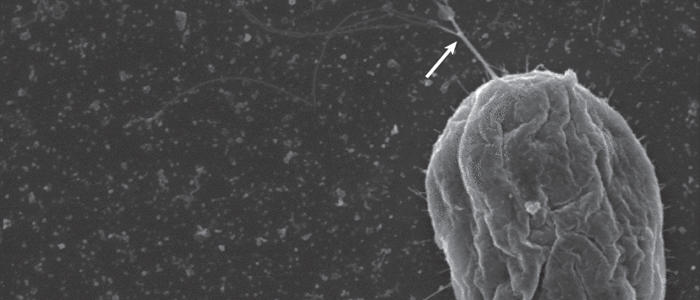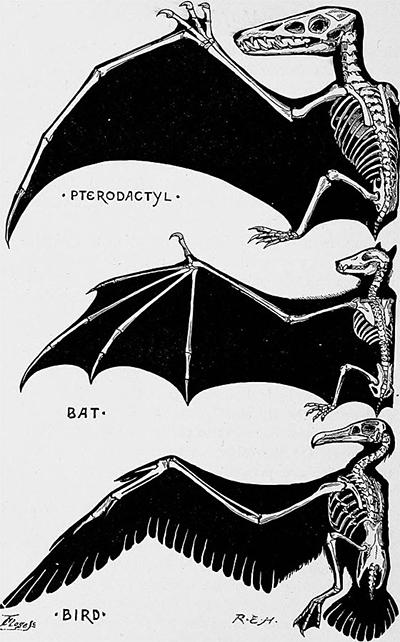The right place at the right time: new bacterium navigates using Earth’s magnetic field
Posted on October 17, 2014 by Jon Fuhrmann
Many migratory birds have a mysterious ability to return home with remarkable accuracy, even from halfway around the world. Since the invention of the compass some 2,000 years ago, humans have been able to emulate this, albeit on a limited scale. But the discovery that even microbes can navigate in a similar manner is relatively recent.
It was only in 1975 that Richard Blakemore, of the Woods Hole Oceanographic Institute in Massachusetts, described the first members of a small group of microbes we now know as magnetotactic bacteria (MTB). Their ability to sense the geomagnetic field and move accordingly is known as magnetotaxis.
Since 1975, a range of MTB have been discovered in several different branches of the tree of life. Besides magnetotaxis, the main thing they have in common is that they live in water and have flagella – whip-like appendages that they use to swim. Unlike birds and people, however, MTB do not use their inbuilt compass to move in a specific direction. In fact, they use magnetotaxis to avoid any north-south or east-west movement: MTB only move up or down within the body of water they live in. This is because they require very specific levels of oxygen concentration, which generally varies with water depth. Moving horizontally would quite simply be a waste of energy for these bacteria.
A group of scientists, led by Dr Yoshihiro Fukumori and Dr Azuma Taoka at Kanazawa University in Japan, have now isolated a particularly unusual MTB from a lake near the university. The novel bacterium does not yet have an official name as it has yet to be grown in a lab. However, the team have been able to get a close enough look to describe the microbe, which is temporarily called GRS-1, in considerable detail. Their findings are published in the journal Microbiology.
Too big to fit
Dr Zachery Oestreicher, a postdoc at Kanazawa University and a member of Dr Fukumori’s team, explains that GRS-1 is very different from all other known MTB. For example, the bacterium is so much bigger than any MTB ever seen before that the team were unsure at first if they were even dealing with a single-celled organism. GRS-1 also swims more slowly than other MTB, making it something of a slow, lumbering beast. This presented the scientists with some difficulties when trying to isolate the bacterium.

Figure 1: The newly discovered bacterium. The arrow points towards its bundle of flagella.
Normally, MTB are isolated using the so-called ‘racetrack method’ – a water sample is placed on a track with a cotton filter in the middle and a magnet at the end. Microbes can move through the cotton, but the MTB, attracted by the magnet, do so much faster than other organisms and are collected on the other side. This approach works because the magnetic field of a magnet at close range is far stronger than the Earth’s geomagnetic field.
However, GRS-1 is so large that it cannot fit in between cotton fibres, rendering the racetrack method infeasible. Instead, Junya Kondo, a former graduate student of Dr Fukumori’s, devised a simple but ingenious method to isolate GRS-1 from their water sample. He strapped a magnet to the side of the bottle containing the water sample and waited a few hours, giving the bacteria enough time to swim towards the magnet. The researchers then took a small sample from the water near the magnet, where the concentration of GRS-1 was now highest.
Repeating this process, the team achieved an even higher concentration of the bacteria in a water sample of just 0.25ml. This sample was small enough to view under a microscope, which they used to isolate individual GRS-1 bacteria using a very fine pipette.
Examining the inner compass
While scientists are still debating the mechanisms that birds use to find their way over vast distances, we have a much better idea of how microbial magnetotaxis works. MTB cells contain specialised structures called magnetosomes, which in turn contain magnetic crystals that act like a compass needle to orient the bacteria. In the case of GRS-1, the crystals consist of magnetite, the most magnetic naturally occurring mineral we know.
But even in the relatively well-understood area of magnetotaxis, GRS-1 presented the researchers with a riddle. Normally, magnetosomes are arranged along the longest axis of each MTB cell. In GRS-1, however, Kondo and his colleagues found that the magnetosomes were distributed in random clusters throughout the cells. It is not yet clear how exactly the movement of GRS-1 differs from that of other MTB as a result, and the team hope to address this question in future papers.
Transferable skills
Despite not being an official species yet, GRS-1 has been found to belong to the class Gammaproteobacteria. Only two other species of MTB have been discovered in this class so far, as recently as 2012 – and neither of these species bear much resemblance to GRS-1. Other known MTB species belong to the Alpha– and Deltaproteobacteria classes, and even to two different phyla (a higher taxonomic rank). How did a feature as specialised as magnetotaxis appear across unconnected branches in the tree of life?

The appearance of a trait in unrelated species is often due to a phenomenon called convergent evolution. This occurs when species from different lineages evolve similar solutions to the same problem. For example, birds and bats both fly, but their ability to do so evolved independently. The resulting mechanics of flight in the two groups are very different, as Figure 2 highlights.
However, convergent evolution is unlikely to have occurred in the case of magnetotaxis. Dr Oestreicher explains that the current model for the presence of MTB in different phyla and classes is horizontal gene transfer. During this process, sections of DNA are passed from one cell to another and ultimately become a part of that cell’s genome. The genes that encode the production of magnetosomes can move into a completely new genome particularly easily.
Even within a group of microbes as disparate as magnetotactic bacteria, the newly discovered GRS-1 is something of an outlier. It differs from other known MTB in a number of ways, and Dr Fukumori speculates that we have yet to discover many other ‘unusual’ MTB. He and his team look forward to playing their part in this undertaking, and in developing potential industrial or scientific applications for magnetotactic bacteria.
Taoka, A., Kondo, J., Oestreicher, Z., & Fukumori, Y. (2014). Characterization of uncultured giant rod-shaped magnetotactic Gammaproteobacteria from a freshwater pond in Kanazawa, Japan Microbiology, 160 (Pt_10), 2226-2234 DOI: 10.1099/mic.0.078717-0
Images:
Header Image: dayna mason on Flickr. Licensed under CC BY-NC-SA 2.0
Figure 1: Taoka et al. (2014)
Figure 2: TomCatX on wikimedia; modified after John Romanes (1892): From Darwin after Darwin

